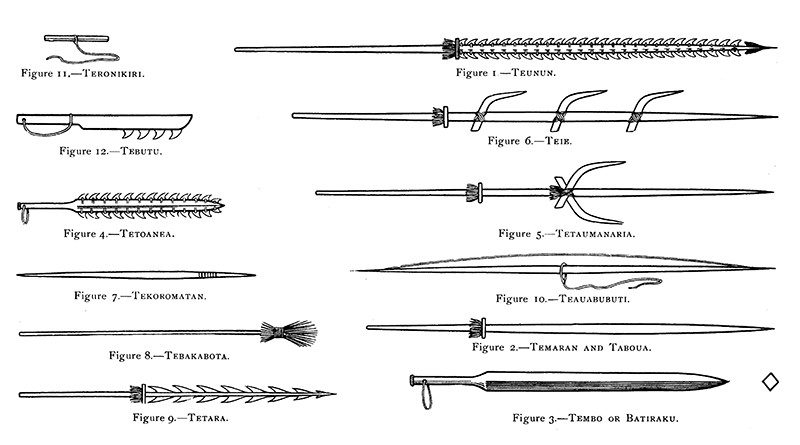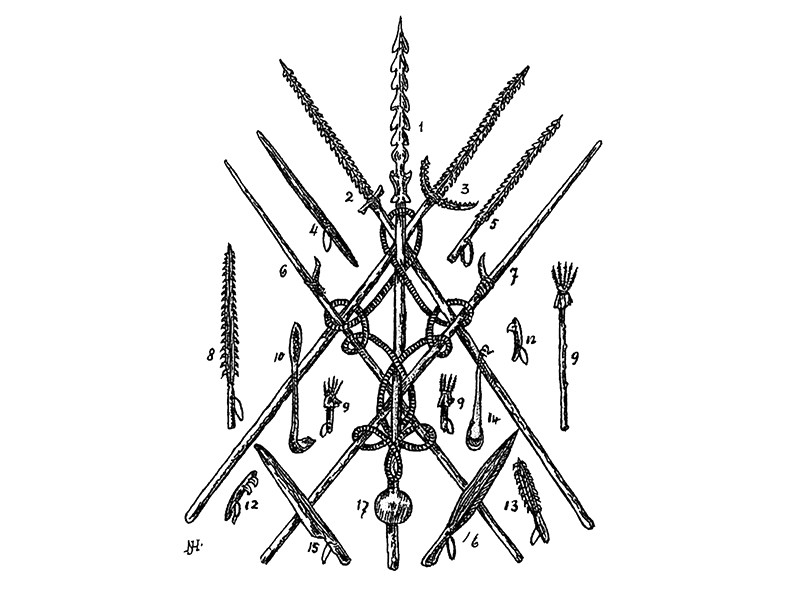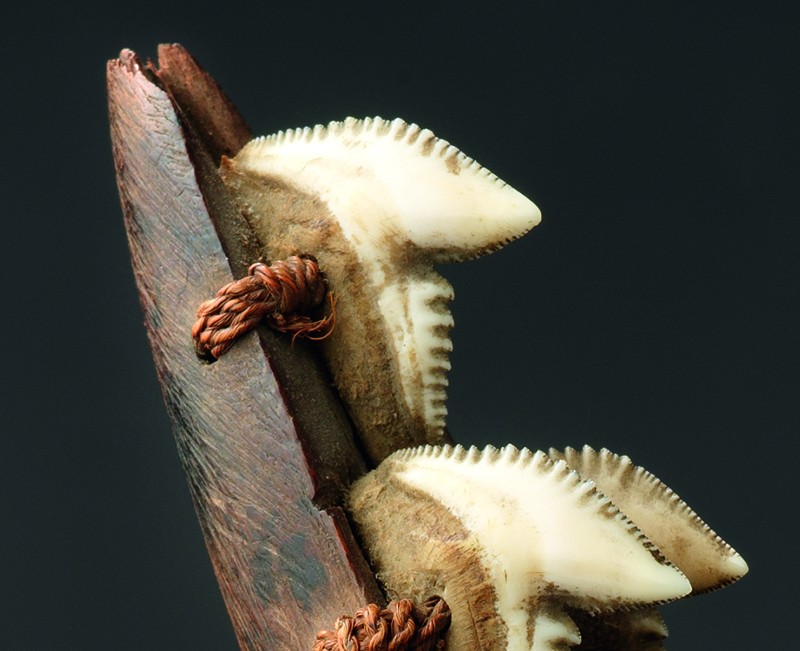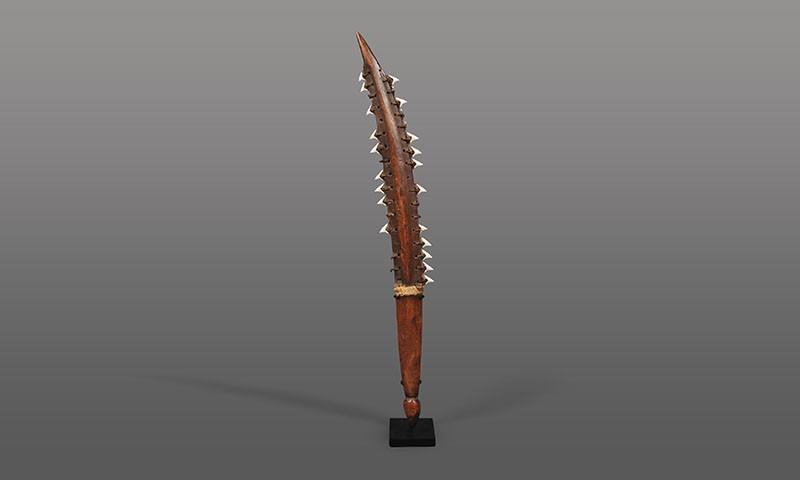© 2023 Kreativa. All rights reserved. Powered by JoomShaper
Bring a Shark to a Knife Fight: Short Blades of the Gilbert Islands
 |
| Knife (Tebutu), 19th Century I-Kiribati culture; Gilbert Islands, Kiribati, Micronesia Palm wood, tiger shark teeth (galeocerdo cuvier) and sennit; 6 1/2 in. 2019.3.1 Bowers Museum Purchase |
War Changes Quite a Bit
If humans have consistently been innovative in any one field, it is in the discovery of more effective ways to injure one another. Often heavily tailored to the materials available in a given region, weapons are quantifiable evidence of a culture’s conflicts and wars. In a previous post, Blade with a Bite: The Shark Tooth Swords of the Gilbert Islands, the Bowers Blog provided an overview of the almost entirely unique shark tooth weapons of the Gilbert Islands. This post homes in on two more shark tooth weapons, a newly acquired knife and a previously acquired dagger, and looks at two of the ethnographers who first classified these weapons and the specific usages of these objects.
 |
| G.M. Murdoch's classification of Gilbertese weapons from Gilbert Islands Weapons and Armour, published 1923. |
Meet the Sources: George McGhee Murdoch
Though several late 19th and early 20th Century ethnographers cursorily cover weapons in their holistic overviews of I-Kiribati culture, there are just two that stand out for building frameworks to classify the various types of weapons found on the islands. The first of these two was George McGhee Murdoch. As a young sea pup, he fell in love with the Gilbert Islands when he managed to make his way there in 1871 at the age of 14. Over fifty years later, and after a long life working independently in the Gilbert Islands and later as a Deputy Commissioner for the British, he wrote a pamphlet outlining 13 different weapon types. His early arrival to the islands meant that he had the opportunity to witness intra-Gilbert Islands wars before they were outlawed when Kiribati became a protectorate of England in 1892.
 |
| Cover of Nicolas Hamann's Die Mordwerkzeuge der Gilbertinsulaner, early 20th Century. |
Meet the Sources: Nicolas Hamann
The other major source for information on these weapons is a German missionary and writer by the name of Nicolas Hamann. First visiting the small chain in 1902, he took a personal interest in the history and legends of the Gilbert Islands, much of which was already disappearing by the turn of the 20th Century. Hamann has been praised for his ability to separate his observations from his judgements, a rare trait among early ethnographers. His sober approach is likely no small part of why he was so attracted to the Gilbert Islands’ weapons. All in all, he identified 17 different types of weapons, many of which used jagged shark teeth for their cutting edges. The numerical variance is mostly attributable to the inclusion of ranged weapons in Hamann’s study. Comparing the work of the two, Murdoch had far more experience among the I-Kiribati but lacked Hamann’s discipline when it came to ethnographic study. For whatever reason it is the former’s framework and observations on I-Kiribati vernacular terms that tend to be used when discussing Gilbertese weaponry.
 |
| Detail of 2019.3.1. |
Knife Prelude
The grandest of the weapons outlined is the teunun, a spear which could be up to 18 feet in length according to Murdoch. The Bowers newly acquired tebutu is at least visually on the far end of the spectrum from the teunun at an average length of 4 to 6 inches. The function of this smaller bladed tool has been described in varying manners with the main consistency being that it would have exclusively been used by women. Ethnographic studies of Gilbert Islands combat mention that the first wave of a battle was generally a non-fatal bout between women of the warring groups. Though no lives were lost, the fighting was described as brutal with the potential to leave a combatant disfigured for the remainder of her life. Other sources describe the usage of the knives in less formal altercations: disagreements over partners and other such matters, but reiterate the damage exacted by these knives. Shark teeth are very sharp, albeit fragile. The teeth may have needed regular replacement but would have been effective at cutting what they were set against.
 |
| Shark Tooth Dagger, mid 19th Century I-Kiribati culture; Gilbert Islands, Kiribati, Micronesia Palm wood, shark skin, shark teeth, reed and sennit; 19 × 2 1/2 × 3/4 in. 2014.17.1 Bowers Museum Purchase |
Dagger Entrée
The longer dagger does not fall easily into any of the categories outlined by either Hamann or Murdoch but has nonetheless become a standard for Gilbert Islands shark teeth weapons. It is so iconic that in 1976 this sword was used for a stamp set. Swords such as this were part of a man’s fearsome arsenal in ritual duels held to defend honor and settle disputes. The main weapons used in such duels were larger shark tooth swords, some featuring three prongs of razor-sharp teeth. This secondary or additional sword would have been used in close proximity to a foe in hand-to-hand combat. In addition to various handheld weapons, duelists also traditionally had a special and lethal battle ensemble consisting of armor made from tightly woven coconut fiber, a belt of stingray skin, palm leaf hand covers with shark teeth attached and a helmet of a dried and hollowed out puffer fish.
Text and images may be under copyright. Please contact Collection Department for permission to use. References are available on request. Information subject to change upon further research.

Comments